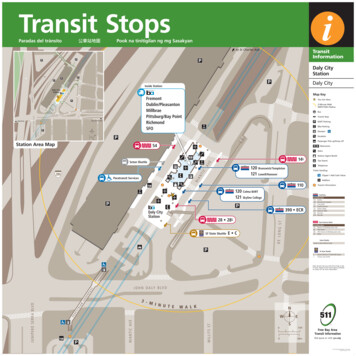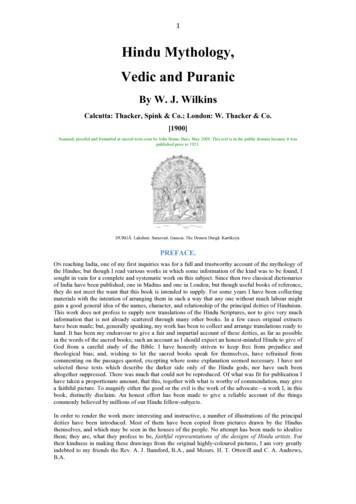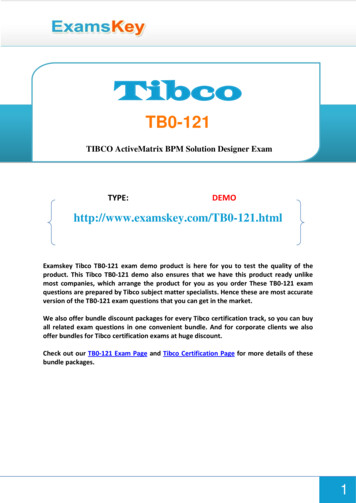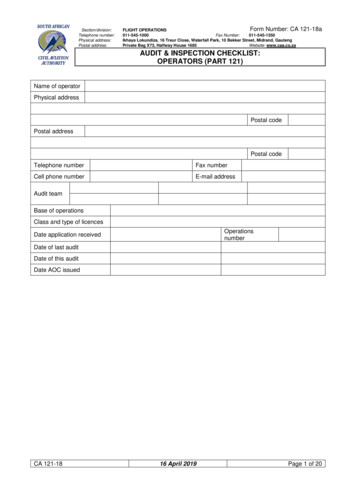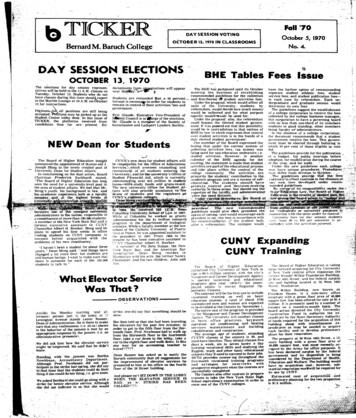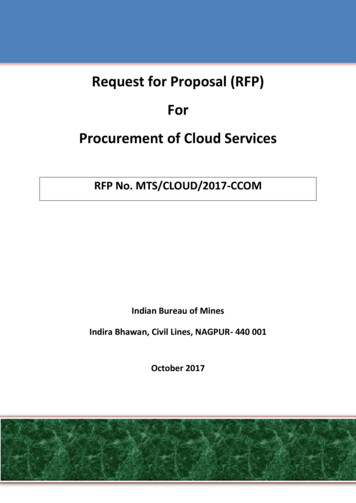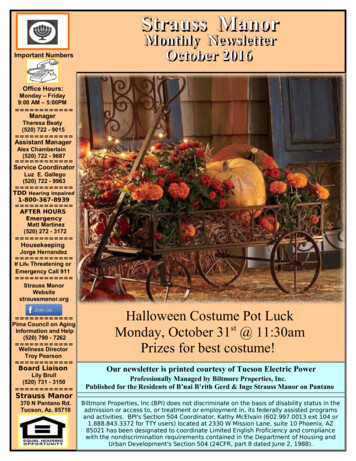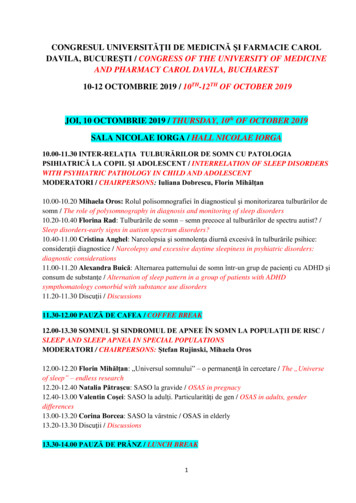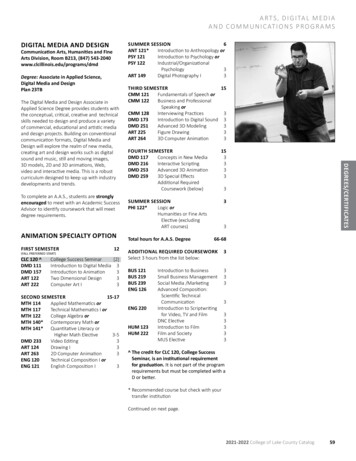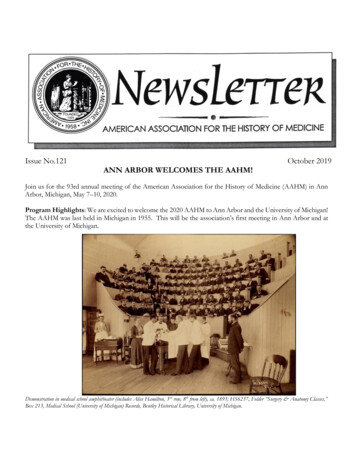
Transcription
Issue No.121ANN ARBOR WELCOMES THE AAHM!October 2019Join us for the 93rd annual meeting of the American Association for the History of Medicine (AAHM) in AnnArbor, Michigan, May 7–10, 2020.Program Highlights: We are excited to welcome the 2020 AAHM to Ann Arbor and the University of Michigan!The AAHM was last held in Michigan in 1955. This will be the association’s first meeting in Ann Arbor and atthe University of Michigan.Demonstration in medical school amphitheater (includes Alice Hamilton, 3 rd row, 8th from left), ca. 1893; HS6237, Folder “Surgery & Anatomy Classes,”Box 213, Medical School (University of Michigan) Records, Bentley Historical Library, University of Michigan.
2AAHM NEWSLETTERThe meeting’s busiest days -- Friday and Saturday -will be held in the Michigan League, built in 1929 inthe center of campus as the center for women’sacademic and cultural activities, and home to someof the nicest conference rooms on campus. We havespacious rooms for the presidential address andreception and for the book exhibit.The Michigan League, Gianna May SanchezThe Garrison lecture will be held directly across thestreet in the historic and recently renovatedRackham auditorium. Some AAHM members willrecall that this is the venue where, in 1955, it wasannounced that field trials directed by ThomasFrancis showed that the Salk polio vaccine was“safe, effective, and potent.” (Fun fact: One of themembers of the local arrangements committee wasan experimental subject in that trial!)Attendees will have opportunities to engage with theacademic community and explore the valuablecollections and educational institutions acrosscampus. We are partnering with the University ofMichigan Museum of Art (⅓ mile from the League)to showcase highlights from collections at UMpertaining to the history of healing and health.The conference will begin and end at theKensington Hotel, with an opening reception onThursday and Sunday’s final sessions.TABLE OF CONTENTSAnn Arbor Welcomes the AAHMAAHM NewsAward Nominations 2020AAHM WebsiteAAHM Distribution ListNews of MembersArchives/Libraries/MuseumsNY Academy of MedicineNational Library of Medicine15567771010The AAHM NewsLetter is edited by Jodi Koste and publishedthree times a year by the American Association for the Historyof Medicine, Inc. It is distributed free of charge to themembership.AAHM OfficersSusan Lederer, Ph.D., PresidentKeith Wailoo, PhD., Vice PresidentJodi L. Koste, M.A., SecretaryHughes Evans, M.D., Ph.D., TreasurerChristopher Crenner, M.D., Ph.D., Past PresidentThe Association’s website is www.histmed.orgAddress all correspondence regarding the NewsLetter to:Jodi KosteTompkins-McCaw LibraryBox 980582Richmond, VA 23298-0582jlkoste@vcu.edu(804) 828-9898News items of 250 words or less are invited and may besubmitted by e-mail, fax, or regular mail. Deadlines: 15February, 1 July, and 1 October.
October 2019Venues: The main conference hotel is theKensington, with accommodations also available atthe adjacent Even wellness hotel. Both of thesehotels are located about three miles south of theUniversity of Michigan campus (with easy andabundant parking). We have also reserved a limitednumber of rooms at the Inn at the Michigan Leagueand Bell Tower Hotel, which are in the immediatevicinity of the League, with hopes that these roomswill be particularly useful for attendees with mobilityconcerns.Getting Around: We will have a well-organized,regularly scheduled and convenient shuttle servicerunning every 30 minutes from the Kensington tothe League. We will also provide extensive anddetailed wayfinding in the form of paper andinteractive maps. Our shuttles will make gettingfrom the hotel to the League easy and fun, andAAHM-ers will have plenty of time to talk and catchup as they move around town. Wayfinder AAHMnavigators will be on hand at the conference hotelsand the League to help attendees find their way atthe conference and on campus. In addition to ourbus service, the University of Michigan has theirown campus bus and there are bus lines locatedalong the route from the hotel to the University ofMichigan. Lyft and Uber are also readily available inAnn Arbor.3downtown and Kerrytown neighborhoods, all ofwhich take reservations and walk-ins. For those whowant to dine closer to the Kensington Hotel, thereis a restaurant in the hotel itself as well as a numberof options within a short walk. A comprehensiveguide to restaurants and events will becomeavailable a few months before the conference.Ann Arbor is renowned for its music scene. TheArk,now in its 55th year, presents 300 shows a yearof roots and folk music in an intimate, 400-seatvenue. Next door, the Blue LLama Jazz Clubfeatures jazz and fine dining, while the KerrytownConcert House, with 110 seats, offers classicalchamber music, experimental, and cabaretperformances. All shows are announced a fewmonths in advance.For those traveling with children, the Ann ArborHands-On Museum can provide hours ofinteractive fun. On Saturday mornings, theKerrytown neighborhood hosts the Ann ArborFarmer’s Market. Kerrytown is also home to theworld-famous Zingerman’s Deli.The Michigan Flyer provides easy, reliable,affordable transportation to and from the airport,with 12–13 round trips a day.Experiencing Ann Arbor: We are excited towelcome you not only to the University of Michiganbut also to Ann Arbor, a vibrant college town witha great deal to offer in terms of dining and othercultural attractions. To begin exploring all that is onoffer, visit Destination Ann Arbor.The Michigan League (the site for Friday andSaturday events) features a coffee shop with goodlunch options on the first floor. There are dozens ofrestaurants at a variety of price points within a fiveminute walk of the League in Ann Arbor’sChildren with polio pioneers button, 1955; HS3718, Folder “PolioVaccine Announcement,” Box 137, Alumni Association (University ofMichigan) Records, Bentley Historical Library, University of Michigan.
4For those who want to venture a bit further, thereare a number of trails along the Huron River,connecting the lovely Nichols Arboretum to a seriesof parks. The Matthaei Botanical Gardens also haswalking paths and a medicinal plant garden. Detroit,home to Motown, the Detroit Institute of Arts, theCharles H. Wright African American Museum,Greektown, and more, is only 45 minutes away bycar.Archives and the University: There are extensivearchival collections related to the history ofmedicine and health at the University of Michigan.These include holdings at the William L. ClementsLibrary, which specializes in material from thefifteenth through the nineteenth century, and haspapers related to colonial herbals and domesticrecipes and regional history; the Bentley HistoricalLibrary, which has countless personal papers andUM departmental records, as well as nineteenthcentury MD theses, and the papers of ThomasFrancis and Eliza Mosher; and the Joseph A.Labadie Collection at the Special CollectionsResearch Center, which has materials documentingsocial movements and marginalized politicalcommunities from the 19th century to the present,including records related to radical literature and thethemes of health and sexuality.Medical history collections include the SindecuseDental History Museum; the Robert Thom “GreatMoments in Medicine” paintings on display at theUM Medical School and Hospital; an early 20thcentury doctor’s office on display in the UMHospital lobby; the Coller Surgical Tools collection;and Roman birth and healing amulets at the KelseyMuseum of Archaeology. The Medical School is alsohome to the Center for the History of Medicine.On campus, in addition to UMMA be sure to checkout the aforementioned Kelsey Museum as well asthe Museum of Natural History, which wasrelocated to a new building last year and features astate-of-the-art Planetarium, as well as being theonly place in the world where you can see a male andfemale mastodon skeleton side by side. UM ofAAHM NEWSLETTERcourse features a very active athletic scene. Guidedtours of Michigan Stadium, the largest stadium inthe US, are available for a fee.Our campus has played an important role in thehistory of medicine. The Medical School admittedits first students in 1850, and has been a leadingforce in medical education. It was the first medicalschool in the US to own and operate its ownuniversity hospital, the first major US medicalschool to admit women, and one of a handful ofleaders in the late-19th-century reform of medicaleducation. The institution now sees about 2.4million outpatient visits per year, almost 50,000hospitalized patients, and is home to over 3,000faculty members and 2,000 medical students andhouse officers.The College of Literature, Science, and the Arts(LSA), home to a good number of medicalhistorians, was created in 1837, when the Michiganlegislature founded UM (moving it from its original1817 incarnation in Detroit). The Department ofHistory was established in 1857. The first femalestudent enrolled in 1870, graduating two years laterwith a degree in literature. Today, with more than100 degree programs in over 75 academicdepartments and programs, LSA is the largest of UM’s 19 schools and colleges and is central to theliberal arts mission of the University.U-M boasts similarly renowned schools and collegesof Pharmacy, Dentistry, Nursing, and Public Health,all of which have contributed to health training andinnovations in the state and far beyond.We are looking forward to seeing you in A2!The 2020 Local Arrangements CommitteeThe University of Michigan is located on thetraditional territory of the Anishinaabepeople. In 1817, the Ojibwe, Odawa, andBodewadami Nations made the largest singleland donation to the University of Michigan,
October 20195offered ceremonially as a gift in the text of theTreaty at the Foot of the Rapids so that theirchildren could be educated. Through thesewords of acknowledgment, their contemporaryand ancestral ties to the land and theircontributions to the University are renewed andreaffirmed.Essays may pertain to the historical development ofa contemporary medical problem, or to a topic withinthe health sciences related to a discrete period in thepast and should demonstrate either original researchor an unusual appreciation and understanding of theproblems discussed. The essay (maximum 9,000words, including endnotes) must be entirely the workof one contestant.AAHM NEWSComplete contest information may be viewed on theAAHM website www.histmed.org/about/Awards orobtained from the Osler Medal Committee Chair:Justin Barr at justbarr@gmail.com. Entries must bepostmarked or submitted electronically via e-mail(which is the preferred method of submission) by 31January 2019.Call for Nominations, AAHM Awards, 2020All awards will be presented at the AAHM annualmeeting in Ann Arbor, Michigan. Additionalinformation may be found on the AAHM website:histmed.org/about/awards.Osler Medal Essay Contest, 2020. The WilliamOsler Medal is awarded annually for the bestunpublished essay on a medical historical topicwritten by a student enrolled in a school of medicineor osteopathy in the United States or Canada. Firstawarded in 1942, the medal commemorates SirWilliam Osler, who stimulated an interest in thehumanities among medical students and physicians.All students who are candidates for the degree ofDoctor of Medicine or Doctor of Osteopathy, or aregraduates of the class of 2019, are eligible. The essaymust have been written while the entrant was astudent in good standing. Students are not eligible tocompete for the Osler Medal if they have completedat least one full year of graduate training in history,the history of science or medicine, or the humanitiesor social sciences by the closing date of thecompetition. Medical students who have beenenrolled in a graduate program in history or a relateddiscipline should submit their essays to the Shryockcompetition. No student should submit an essay toboth competitions in the same year. Essays that havebeen awarded an Honorable Mention are not eligiblefor resubmission.Shryock Medal Essay Contest, 2020. Graduatestudents are invited to enter the Shryock Medal EssayContest. The medal honors Richard HarrisonShryock (1893–1972), a pioneer among historiansinterested in the history of medicine. The award isgiven for an outstanding, unpublished essay by asingle author on any topic in the history of medicine.The essay (maximum 12,000 words, includingendnotes) must be the result of original research orshow an unusual appreciation and understanding ofproblems in the history of medicine. In particular, thecommittee will judge essays on the quality of writing,appropriate use of sources, and ability to addressthemes of historical significance.This competition is open to students enrolled in agraduate program in history or a related discipline atthe time of submission. Medical students who havebeen enrolled in such a program should submit theiressays to the Shryock competition. No studentshould submit an essay to both competitions in thesame year. Essays that have been awarded anHonorable Mention are not eligible forresubmission.Questions and submissions should be directed toShryock Medal Committee chair: Cynthia ked or submitted electronically via e-mail
6(which is the preferred method of submission) nolater than 31 January 2020.J. Worth Estes Award, 2020. This award wasestablished in honor of J. Worth Estes, M.D., inrecognition of his many invaluable contributions tothe American Association for the History ofMedicine and to scholarship in the history ofmedicine. The award is made annually for the bestpublished paper in the history of pharmacologyduring the previous two years, whether appearing ina journal or a book collection of papers. The choiceof topic reflects Worth Estes’ long tenure asProfessor of Pharmacology and ExperimentalTherapeutics at Boston University and his ownscholarship in the history of pharmacology.For the purpose of this award, the history ofpharmacology will be defined broadly to includeancient and traditional materia medica, folk medicines,herbal medicines, the pharmaceuticals of the modernera, pharmaceutics, and the like. It shall encompassthe discovery of medicaments, basic investigationsabout them, their characteristics and properties, theirpreparation and marketing, and their therapeuticapplications.While the committee will be monitoring relevantjournals and books where such papers might appear,they welcome nominations of papers that would beeligible for consideration. The nomination shouldconsist of a letter citing the work nominated alongwith a copy of the paper. For the current award,candidate papers will be those published in 2018 and2019. Papers in languages other than English shouldbe accompanied by a translation or detailed precis.Nominations should be directed to the Chair of theCommittee, Luc Richert at lucas.richert@wisc.eduand must be postmarked or submitted electronicallyvia e-mail (which is the preferred method ofsubmission) no later than 17 January 2020.Jack D. Pressman-Burroughs Wellcome FundCareer Development Award in 20th CenturyHistory of Medicine or Biomedical Sciences,AAHM NEWSLETTER2019. This award honors Jack D. Pressman, Ph.D., adistinguished historian of medicine and AssociateProfessor of the History of the Health Sciences at theUniversity of California, San Francisco at the time ofhis early and unexpected death in June 1997. Theaward and stipend of 1,000 is given yearly foroutstanding work in twentieth-century history ofmedicine or medical biomedical sciences, asdemonstrated by the completion of the Ph.D. and aproposal to turn the dissertation into a publishablemonograph. The Ph.D. must have been completedand the degree granted within the last five years (i.e.,2015–2019). The application must include acurriculum vitae, the dissertation abstract, a one-pagesummary of the proposed book; a description (notexceeding two pages) of the work to be undertakenfor publication; and two letters of support fromfaculty members knowledgeable about the applicant’sdissertation.The application, including all supporting materials,must be submitted by 31 December 2019.Submissions and/or questions should be directed tothe Chair of the Pressman–Burroughs WellcomeCommittee, Jacob Steere-Williams atsteerewilliamsj@cofc.edu.AAHM WebsiteAAHM now has a members’ only content section ofits website where you can find useful informationavailable only to those in the Association. After muchback and forth with our membership serviceprovider, Johns Hopkins University Press (JHUP),over the course of the last year, we are now able toprovide a secure, gated space where we can postcontent only available to our members. To log in tothe members content, go to the AAHM websitewww.histmed.org and click on “members” in theblack navigation bar. This link will take you to thepage where you may enter your user name andpassword. Your login is whatever have set-uppreviously with JHUP while renewing yourmembership or registering for the annual meeting.Use the links on the login page to reset yourusername or password if you have forgotten either.
October 2019In the Members Content section, you will findAAHM’s statement of principle on nondiscrimination and sexual harassment as well as theAssociation’s trolling response guidelines. For thoseof you who like to have a printed membershipdirectory around, you will find in the MembersContent, a directory of members with theirinstitutions, email addresses, and phone numbers asof October 2019. The most up-to-date membershipinformation can always be found in the onlinedatabase maintained by our membership serviceprovider, Johns Hopkins University Press.AAHM Distribution ListOver the past year, we have encountered a numberof difficulties in sending posting on the officialAAHM distribution list. As a result, some membershave missed notification about membership renewal,the annual meeting, call for papers or awards, andother important announcements. Some of theproblems we can attribute to the rather antiquatedmailing list software available through our webhosting provider. The dot com part of the sendingaddress caused many messages to end up inmembers’ junk mail or spam folders.To avoid some of these pitfalls, we have sent up anew distribution list at the home institution of theAAHM secretary. Now you will receive officialannouncements and notifications from LIB-AAHML@lists.vcu.edu. We hope the use of the “edu”domain will allow messages to be received on aregular basis. Please contact Jodi Koste atjlkoste@vcu.eduif you believe you are still unable toreceive messages from the list. Remember this is adistribution list only so you cannot reply to it or post.7NEWS OF MEMBERSThe Johns Hopkins University Press has publishedan updated edition of Warwick Anderson’s TheCollectors of Lost Souls, with an extensive afterword.The first edition was awarded the William H. WelchMedal of the AAHM; the Ludwik Fleck Prize of 4S;and the NSW Premier’s award for General History.Additionally, with James Dunk, Tony Capon andDavid S. Jones, he has written a historical article onmedical responses to climate change, “Human Healthon an Ailing Planet,” published in the New England J.of Medicine 381 (2019): 778-82.ARCHIVES/LIBRARIES/MUSEUMSArchives & Special Collections at ColumbiaUniversity Irving Medical Center’s Augustus C.Long Health Sciences Library is pleased toannounce the opening of the papers of Dr. MathildeKrim (1926-2018), biomedical scientist, pioneerAIDS activist, and philanthropist.To access information about the papers, researchersshould start with the record in CLIO, the ColumbiaUniversity Libraries’ online public accesscatalog: clio.columbia.edu/catalog/14267453 fromthere a link connects to the finding aid.At the outset of the AIDS epidemic Krim recognizedthe urgent need to meet its devastating medical andsocial effects. In 1983, she founded the AIDSMedical Foundation (AMF), the first privateorganization to support AIDS research. Two yearslater AMF and the National AIDS ResearchFoundation merged to become the AmericanFoundation for AIDS Research, popularly known asamfAR (it is now known as amfAR, The Foundationfor AIDS Research). It soon became the country’sleading non-profit organization devoted tosupporting AIDS research, prevention, andscientifically sound public health policy. Besidesbeing amfAR’s founding chair, Krim served as itsBoard chairman from 1990 to 2004. In these rolesshe became one of the country’s most visible
8advocates for the need to adequately fund AIDSresearch as well as an outspoken champion of thehuman rights and dignity of persons with AIDS.Krim’s papers are 65 cubic feet in extent, housed in182 boxes. They are largely professional in nature andcover her entire career, dating from circa 1948 to2016. Besides her AIDS activism, the papers containmuch relating to her important earlier work withInterferon at Memorial Sloan-Kettering CancerCenter. The papers include printed-out emailcorrespondence, letters, memoranda, notes, reports,minutes, meeting materials, financial interviews, congressional testimony, conferenceproceedings, brochures, programs, and audiovisualmaterials.The bulk of the papers is open to researchers withoutrestrictions. A small amount of material is closed fora specific period of time while access to other recordsis restricted under the terms of the Privacy Rule ofthe U.S. Health Insurance Portability andAccountability Act (HIPAA).The papers were processed and the finding aidwritten by Jennifer Ulrich, Technical ServicesArchivist. For more information about the KrimPapers please contact Archives & Special Collectionsat hslarchives@columbia.edu.The Historical Medical Library of the College ofPhysicians of Philadelphia is pleased to announcea major new addition to its digital collections with theonline publication of much of our primary sourcematerial related to the life and work of Silas WeirMitchell (1829-1914).A Fellow and President of the College of Physiciansof Philadelphia, Mitchell was a prominent 19thcentury physician and writer best remembered for hisdiscovery and description of phantom limbsyndrome and, controversially, as the inventor of therest cure, the basis for Charlotte Perkins Gilman’sbook The Yellow Wallpaper. A complex figure, his trueAAHM NEWSLETTERimpact on 19th century medicine and culture is stillbeing uncovered.Presented via a dedicated site, this research portalcontains the fully digitized content of three majorcollections held at the Historical Medical Library: TheSilas Weir Mitchell Papers (MSS 2/241-03), The SilasWeir Mitchell Collection (MSS 2/241-04) and theTurner's Lane Hospital case and follow-up studies ofperipheral nerve disorders (Z10 40). The digitizationand presentation of these materials offersunprecedented access for scholars in the history ofmedicine and medical humanities, as well as thesimply curious.You will find the satSpecial Collections and University Archives,Library of the Health Sciences, University ofIllinois at Chicago is excited to announce theacquisition of the Paul Peck Collection of MedicalArt. The collection contains more than 450 pieces oforiginal medical art completed by Paul Peck for atleast two medical atlases published by Merck & Co.Paul Peck began his medical illustration career atNew York University, graduating in 1929, andcompleted graduate training in art education atColumbia University and in gross and microscopicanatomy at the Johns Hopkins Medical School. Heserved as a chief medical artist in the Office of theU.S. Surgeon General and in the Army Institute ofPathology during World War II. He taught othermedical illustrators, while in the service and as acivilian, at New York University, Hunter College,Pratt Institute and the Institute of Adult Education.Peck compiled numerous anatomy, pathology andsurgery atlases over his career.UIC is a fitting repository for Peck’s medicalillustrations, and students in UIC’s College ofApplied Health Sciences’ Biomedical Visualization(BVIS) program will be able to examine hand-drawnartwork from a prominent practitioner working in themid-20th century. BVIS, the largest and second-oldest
October 2019of four accredited programs in the U.S., nowincorporates science and technology for animation,gaming and virtual and augmented reality.The Carl W. Gottschalk Collection on theHuman Kidney is housed at the Wilson SpecialCollections Library at the University of NorthCarolina at Chapel Hill’s University Libraries.The collection contains more than 12,000 books,pamphlets, periodicals, illustrated materials, andmanuscripts dating from the 16th through the 20thcentury. Collected by renowned nephrologist andbibliophile Carl W. Gottschalk, this is one of themany examples of the University Libraries’commitment to documenting the history ofmedicine. A handful of the many highlights from thisdistinguished collection includes Rene Descartes’s DeHomine (1662), Marcello Malpighi’s De ViscerumStructura Exercitatio Anatomica (1666), Richard Bright’sReports of Medical Cases (1827), Simon Gustav’sChirurgie der Nieren (1871), Jean Oliver’s Architecture ofthe Kidney in Chronic Bright’s Disease (1939), and WillemJ. Kolff’s The Artificial Kidney (1946). The collection,which also includes Dr. Gottschalks’ kidney-shapeddesk and other furnishings, is on display in WilsonLibrary’s Fearrington Reading Room. Special toursare available upon request.The Wilson Special Collections Library also owns aseparate manuscript collection of Dr. Gottschalk’swritings and illustrations, research materials,biographical materials, and correspondence andrelated materials, documenting his medical research,teaching career, university administration functions,and other interests such as book collecting.Dr. Carl W. Gottschalk was professor of medicineand physiology at the University of North Carolina'sSchool of Medicine, 1952-1969, and Kenan Professorof Medicine and Physiology, 1969-1992. He served aschair of the Committee on Chronic Kidney Disease,sponsored by the United States Bureau of the Budget,which issued its influential Report of the Committeeon Chronic Kidney Disease in 1967. He was alsoknown for his Diseases of the Kidney, first publishedby Little Brown in 1988.9Gottschalk was named an American HeartAssociation Career Investigator and won the NorthCarolina Medal and the O. Max Gardner Award. In1970, he received the Homer W. Smith Award fromthe New York Heart Association; in 1990, the A. N.Richards Award of the International Society ofNephrology; and, in April 1993, the first Robert W.Berliner Award for Excellence from the AmericanPhysiological Society. Gottschalk was president ofthe American Society of Nephrology and a memberof the National Academy of Sciences, the AmericanAcademy of Arts and Sciences, and the Institute ofMedicine. He died in Chapel Hill in 1997 at the ageof 75. His widow, Dr. Susan Fellner, donated thecollection to UNC shortly after his death.One of Dr. Gottschalk’s mentors was thenephrologist Jean Oliver, who bequeathed hisprofessional papers to Gottschalk upon his death in1976 at age 87. These materials, which includeOliver’s original laboratory notebooks andphotomicrographs of kidney dissections, are part ofthe Jean Oliver Papers, also housed at the WilsonSpecial Collections Library. Oliver’s professionalhonors include the Thomas Addis Memorial Medalof the National Nephrosis Foundation, the BordenAward in Medicine, the Gold Headed Cane award ofthe American Association of Pathology andBacteriology, and the Homer Smith award in renalphysiology.Sherman Grinberg Film Library seeks ways toshare its historic newsreel footage with the researchcommunity. The library is the home of theParamount and America Pathe newsreels and reporthaving 126 historic newsreels on their website underthe term “medical”.There are two options to view the newsreels: Onemethod is to browse the footage available online(approximately 30% of their holdings). If youvisit filmlibrary.shermangrinberg.com andputyour search terms into the browse window usingquotation marks, you can see footage that has alreadybeen digitized. Second, you can contact their managerof media archives and licensing to create a finding aid
10based on your keywords. The staff will search theirvault for footage and if there is any available willdigitize it and send digital screeners for review. Forfurther information, contact Lance Watsky atlwatsky.dma.grinberg@gmail.comThe Library and Center for the History ofMedicine and Public Health, The New YorkAcademy of MedicineThe Library recently partnered with Gale, a Cengagecompany, to digitize materials for two massdigitization projects: Public Health in ModernAmerica, 1890-1970, launched in June 2019 andArchives of Sexuality & Gender, Part III: Sex andSexuality, Sixteenth to Twentieth Centuries, launchedin February 2019. Within the past year, thecollaboration with Gale has helped the Library todigitize over 6,600 items, which represents almost amillion images created.Public Health in Modern America includes: TheCommittee on Public Health of the New YorkAcademy of Medicine–a collection of correspondence, reports, minutes, and documents on thesignificant work of the committee with New York’shealth department and leading figures in publichealth. It is a collection about the New YorkAcademy’s contribution and role in public health atthe time.Library of Social and Economic Aspects of Medicineof Michael M. Davis–a collection of the work of Dr.Davis in the early twentieth century, covering topicssuch as healthcare, medical economics, socialsecurity, legislation, and more.Selected Public Health Pamphlets–over 2,200pamphlets on various aspects of public health fromthe late nineteenth century to the mid-twentiethcentury.Archives of Sexuality & Gender includes:Mono
want to dine closer to the Kensington Hotel, there is a restaurant in the hotel itself as well as a number of options within a short walk. A comprehensive guide to restaurants and events will become available a few months before the conference. Ann Arbor is renowned for its music scene. The Ark,now in its 55th year, presents 300 shows a year
